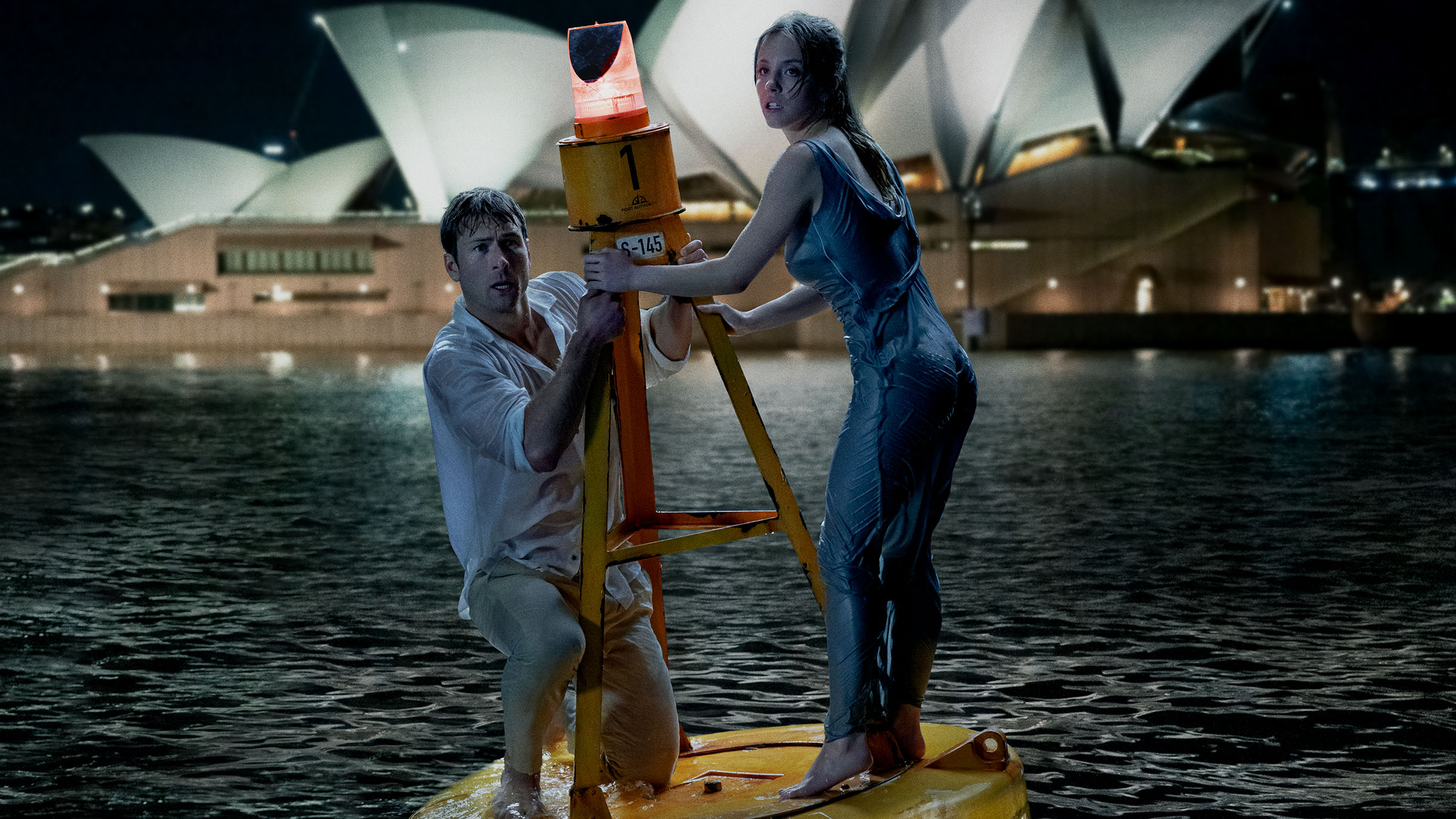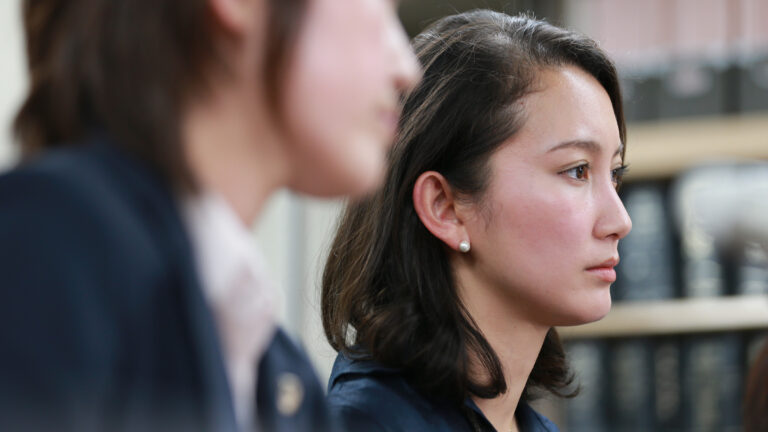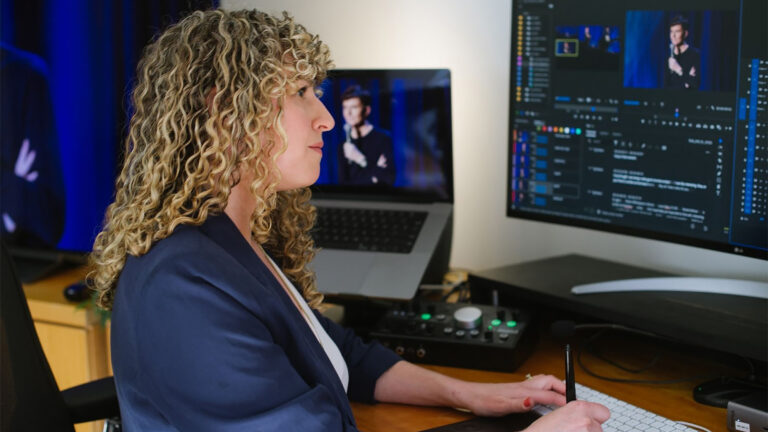Anyone But You editors Tia Nolan, ACE and Kim Boritz-Brehm reunite and meet cute once again for a film that has been an absolute box office smash. In an era where prevailing “wisdom” says that you can’t get audiences out to the theaters for a romantic comedy, Tia and Kim’s little $25 million film has racked up over $200 million worldwide!
Summary for Anyone But You
Loosely based on Shakespeare’s Much Ado About Nothing, Anyone But You was directed by Will Gluck, who co-wrote the screenplay with Ilana Wolpert. The film stars Glen Powell as Ben and Sydney Sweeney as Bea. Despite having an amazing first date, Bea and Ben’s initial attraction quickly turns sour. When they unexpectedly find themselves at a destination wedding in Australia, the pair pretend to be the perfect couple to keep up appearances.
In our discussion with Anyone But You editors Tia Nolan, ACE and Kim Boritz-Brehm, we talk about:
- Surviving spiders
- Keeping your leads likable through conflict
- Breaking the box office with a rom-com
- Nailing down the needle drop
- The Richard Marks connection
Listen as you read…
Editing Anyone But You
Matt Feury: Tia, you’ve worked with writer-director Will Gluck for a while now. Tell me how you two met, the projects that you’ve worked on together, and how that all led to Anyone But You.
Tia Nolan, ACE: We started on a movie called Friends with Benefits. I was a late hire on that, so I hit the ground running with him. I believe the project had been delayed and he’d lost his editor. There was some sort of complication, so I jumped in with Will.
We kind of had the same sensibilities. He did a short-lived TV show after Friends with Benefits called The Michael J. Fox Show. I did the pilot and one episode of that, another pilot that he produced, and then we jumped into Annie. This is our first feature together since Annie because he did two Peter Rabbit movies and they were both in Australia. The editor had to be Australian to get all the tax breaks. It was fun to be back together again.

MF: Kim, this is your first project with Will, but you and Tia have worked together for a while. Tell me how you two met, the projects you’ve worked on since then, and how that led to you getting the call for this film.
Kim Boritz-Brehm: It’s funny, Tia and I have a history with an editor named Richard Marks. He got me into the industry as an editorial P.A. when we were shooting How Do You Know in Philadelphia, where I’m originally from. An editor that I had worked with before, Debbie Berman, introduced me to Peter when he was looking for a first assistant for Thunder Force. It was funny when we realized that we both had a Ritchie connection because Tia had worked with Ritchie pretty much from the very beginning. Isn’t that right?
Tia Nolan, ACE: Almost. He was my mentor for over a decade. We worked on many projects together. I worked with a few other New York editors before him. They were my stepping stones to get to Richard Marks, the famous editor. I worked those connections to get to him. He helped mold my career.
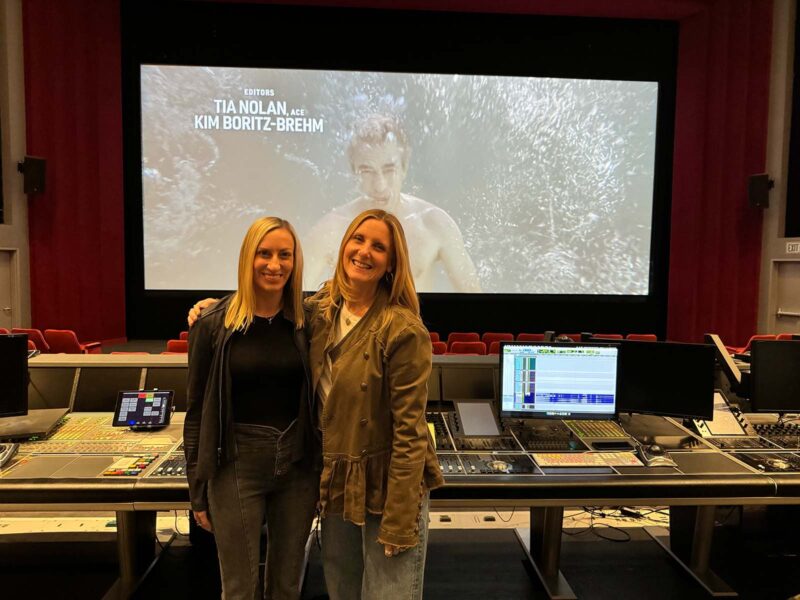
MF: This movie is loosely based on Shakespeare’s Much Ado About Nothing. There are quotations from the play embedded into the background as title cards and in the dialog, almost like Easter eggs. Did you read or reread Much Ado before working on this movie? And did Will give you any other reference material?
Tia Nolan, ACE: I didn’t reread it beforehand, but there were times when we would scramble to find the most appropriate quote. So I was speed reading Much Ado during the process, which is not easy.
Kim Boritz-Brehm: Google was our best friend in that search.
Tia Nolan, ACE: Very true. But Google would get it wrong. A lot of times Google or the little high schools Shakespearean websites would quote from the wrong play. So we’d put it in and someone else would say, “That’s not from Much Ado. That’s from A Midsummer Night’s Dream.”
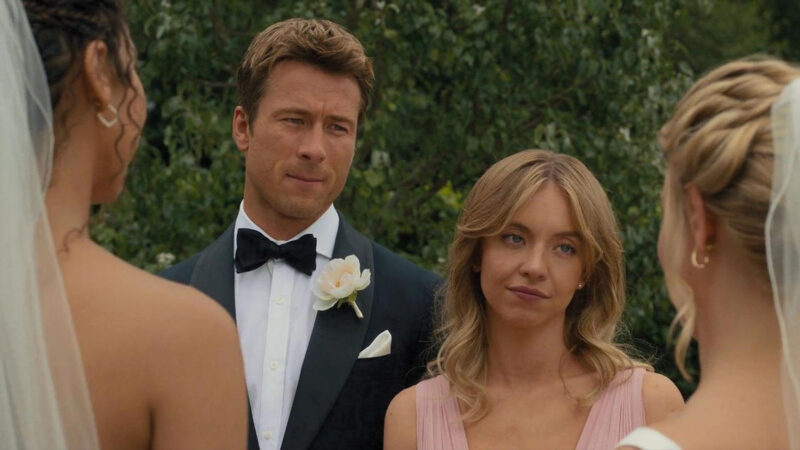
MF: Once you read a script and agree to do the film, what do you do next to prepare for it?
Tia Nolan, ACE: When I work with Will he just keeps sending me scripts. I think we started in the beginning of March. Kim and I were overlapping with another film for the same studio, so it’s a little blurry. But from around November, when Will and I started talking about it and throughout shooting, he would send me a draft literally every Friday night. It was one of those things where I would say, “Yeah, it’s the weekend! Okay, no, I have work to do.” I was able to give Kim the scripts when they got to the studio level because Will was treating me as a trusted family member. He was trying to get notes so that he could get the scripts to the studio.
My prep time is all about living in the script with those characters with Will and helping him with the story and with visual transitions, or if I saw things that I felt we were never going to keep. That’s what my prep is up until diving into the movie.
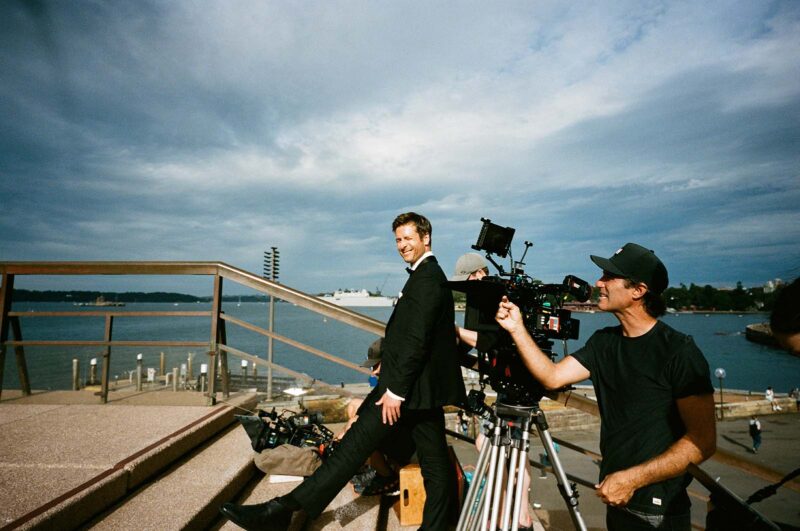
Kim Boritz-Brehm: Our first couple of weeks were a whirlwind because we had to wait for Nick Coker, our first assistant editor. He had to leave a film called Harold and the Purple Crayon for us.
Tia Nolan, ACE: Kim started as my first assistant editor, but began editing with me on Thunder Force. Then we got brought in sort of late in the game into a film that hasn’t been released yet. One of Kim’s jobs on that film was editing an animated sequence that went on long after the film wrapped. She stayed behind to hone it in, because that’s how animation goes. So for the first couple of months Kim was going back and forth, trying to work on that sequence.
For Anyone But You, we had the usual prep meetings with the Australians. They structure their post-production a little differently than we do, so we had to sort through that and get everything working on the same page. That’s always a challenge when you’re far away and the time difference is so huge.

MF: Kim, when you joined Anyone But You, what did you and Tia need to hash out between each other in terms of tackling this project?
Kim Boritz-Brehm: In this case, it was about me following Tia’s lead. She had already worked for Will and she knows what he likes. Tia would say, “I’m giving you this scene today” and I would work on it. After, there would always be a pass with her notes, showing her my cuts, polishing, and all of that. Then we would send it to Will. I think our cutting became pretty seamless. I learned from the best. I’m honored because sometimes Will couldn’t tell which scenes were mine and which scenes were hers. They worked so well together.
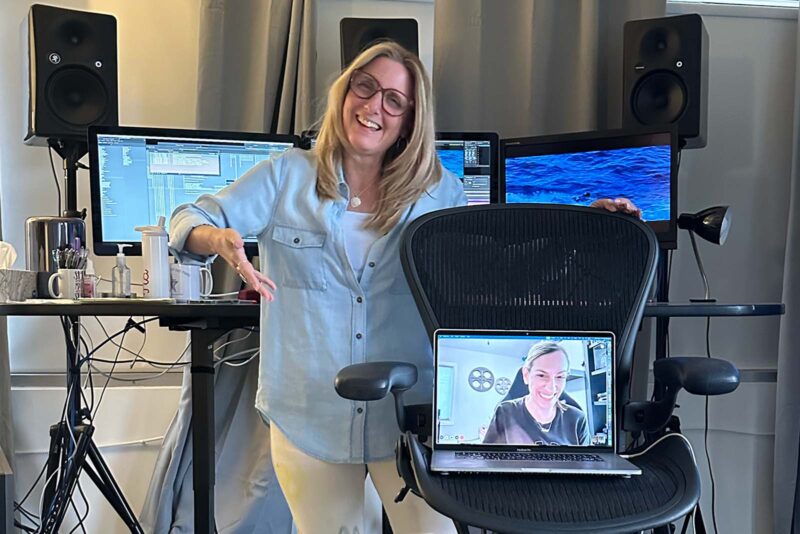
MF: How did you balance your editorial workload?
Tia Nolan, ACE: We would look at the schedule ahead of time to know what they were going to shoot the next day. There were certain sequences that I had spent a lot of time discussing with Will, so I took those because we had already sorted it out. He gave me notes about how he was going to shoot things, so I would trust that he’d want to talk to me directly.
It’s about living in something. When I edit a scene, I start to live in it. I get so familiar with the footage that I can anticipate how I want to cut something. And if Will has a note or if something isn’t working, I can solve the problem because I know the footage backward and forward.
When I edit a scene, I start to live in it.
I wanted to be on top of certain sequences because I knew Will was concerned about them. I would selfishly take on those scenes all by myself. Then we would get other footage in and I would be bogged down with those sequences, so Kim would step in and take those. Sometimes those were also very heavy-hitting scenes.
Once Will was in the cutting room with us, I would just kick him into Kim’s room and say, “That’s her scene, go work with her on it” or she’d come into the room with us. She would sit at the AVID and I would sit on the couch, which never happens. I would pretend to be a studio person or whatever.

I agree with Kim, it became seamless. This happened when I worked with Kim on Thunder Force too. I gave her a couple of scenes and had very minor notes on them, and she was able to turn around my notes pretty instantly. Then we would have a scene that felt like any other scene before or after it, which is important when you have multiple editors. Editors can have different cutting styles.
MF: Anyone But You shot predominantly in Australia. If it wasn’t, that was some great VFX work. Where were you cutting?
Tia Nolan, ACE: We were in L.A. We started on the Sony lot because we were overlapping with the other film. We almost had our hands on two different films at the time. Then we moved to West Hollywood, where Will’s company, Olive Bridge Entertainment, is located. It ended up being a lovely space, but it was loud. We were in the midst of West Hollywood on one of the busiest corners in what could be called a “rustic industrial” type of space. If you think of those two words and also sound, it’s not conducive to good sound quality at all.
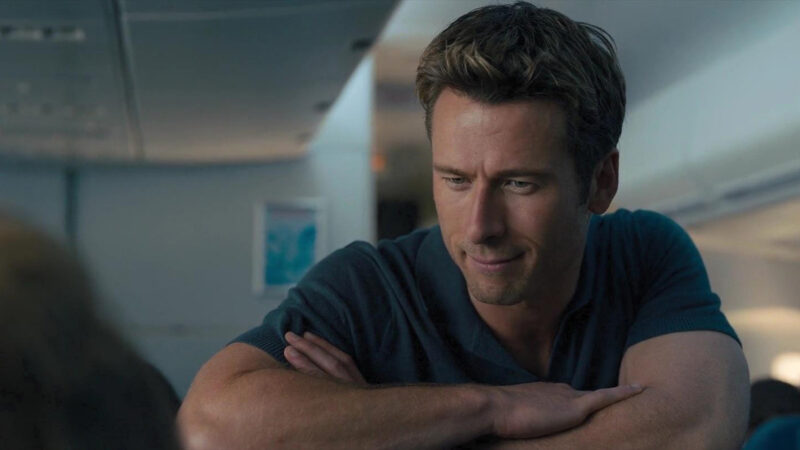
MF: How long was the shoot, how long was post, and how long were any reshoots that might have happened?
Tia Nolan, ACE: The shoot was something like two and a half months. And then there were the strikes and we also did some additional photography. The film went longer than we had anticipated. I believe we wrapped in the beginning of December. We were originally supposed to wrap before Thanksgiving, but some additional photography needed to be done. So we were waiting out the strikes to get that in. Then we had to scramble to get it into the theaters because we had a month or less to get it on screen.
MF: Kim, do you and Tia watch dailies together even if they’re for scenes you may not be cutting? Do you and Tia have regular meetings? What do you do to keep the movie feeling unified like it’s done with one editor or one vision?
sydney sweeney and glen powell behind the scenes of their new rom com ‘anyone but you’ pic.twitter.com/BIZwUwDnB9
— rom com archive (@romcomarchive) March 21, 2023
Kim Boritz-Brehm: We didn’t get to watch all the dailies together. Will shoots a lot of footage. He loves multicam. Sometimes three cameras were going at once. In terms of footage, Tia had to focus on the scenes that she was cutting. Then I would jump in and do the other scenes. But I made it a point to watch as much of the footage as possible. You have to know everything because Will knows everything. He asks a lot of questions and he remembers very specific things in a take. It’s important to keep up with him.
Tia would bring me in after she cut a scene and show it to me. She would also bring the rest of the crew. That’s what’s great about Tia. She thinks everyone should be familiar with the film and be part of the creative process. Everyone would sit in the room, give notes, run ideas, talk about character arcs, and where it all was going. That’s so important, especially while Will’s shooting, to make sure that everything is coming together.
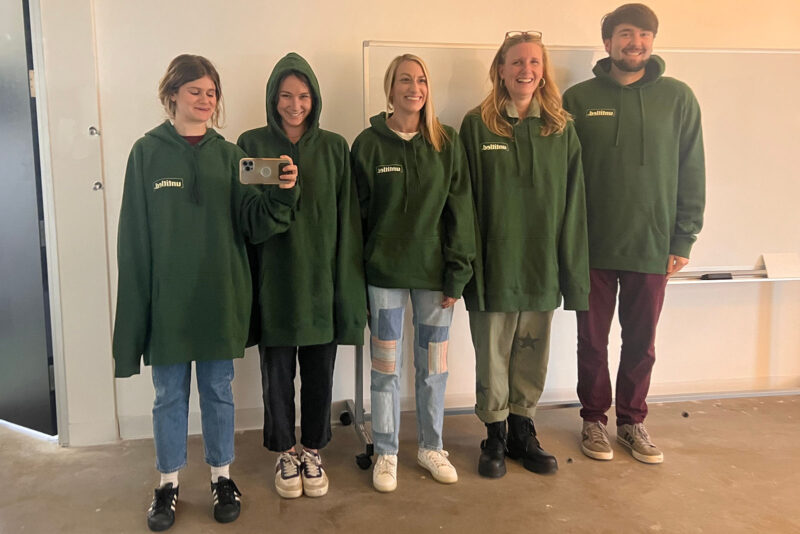
MF: You said that Will likes to ruin your weekends with his script updates. In a good way, I’m sure. But is there a lot of interaction with him when he’s in production?
Tia Nolan, ACE: Since Will hadn’t worked with Kim before, I was the point person during production. When I work on a film, I will do a daily report every day. Some directors don’t respond to the report at all, but others do. They love it. Every day, I’ll say, “Here’s what I watched. This is working. You might want this, that, and the other thing.” I let them know that I’ve seen everything and I’ll ask some questions about intention.
Will often keeps the camera running and restarts. He’ll either do that for full takes or he’ll restart for line reads. We were getting about six to eight hours of footage a day. That’s happened when I’ve worked with him in the past, especially on the Annie musical numbers. We sometimes had eleven hours of footage at the end of the day. That’s my whole work day. How am I watching all of this? I will watch multiple cameras grouped together. Kim and I both do that because you have to get through the footage.
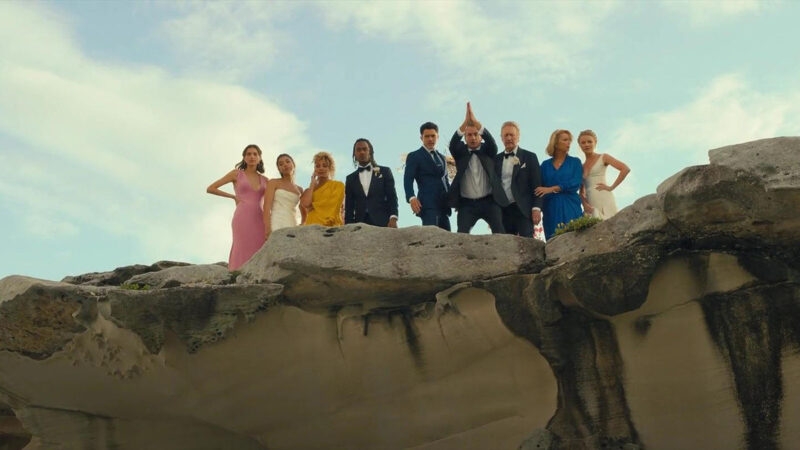
I have constant communication with Will. He will text or call me during work to say, “We’re about to do this. What do you need?” I also send him scenes at the end of almost every day just to say, “Here’s what you’ve got.” There was a scene fairly early on that was shot in an airplane. It’s the scene where Bea is trying to steal Ben’s cookie. There were a lot of extras on the plane, including Glen Powell’s parents. The woman who lifts up her sleep mask is Glen’s mother and the person asleep next to Glen is his father.
It was a complicated day and certain inserts that I think would have helped the comedy were missed. I brought that up to Will and he was able to scramble and get an additional day on that airplane set, which was an actual airplane in a museum somewhere. It wasn’t a functioning airplane. But they had to make special arrangements to go back.
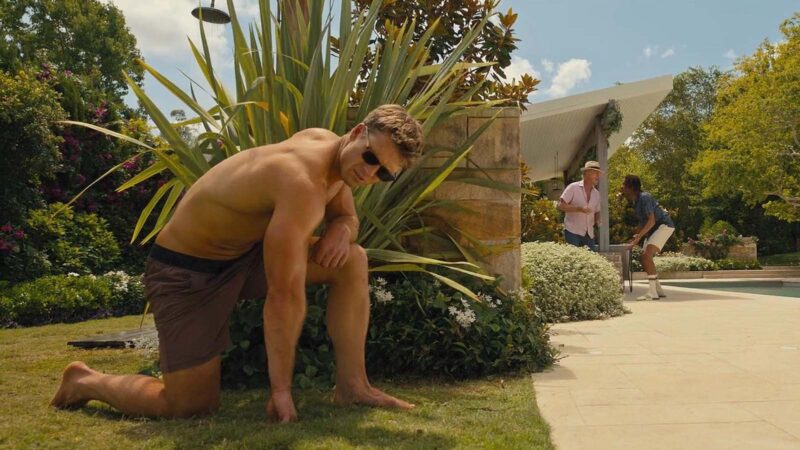
MF: Does it make things more efficient in the cutting room when the director is also a writer?
Tia Nolan, ACE: Will is good at rewriting a scene in the cutting room. He doesn’t hold on to things as if they are precious. He started out on half-hour comedies, so I think the writers’ room mentality of never being precious about your material added to that.
Kim, you probably experienced that in the scene where Bea’s dad, Dermot Mulroney, tries to dive into the swimming pool. That scene became what it is today because of a huge suggestion made by Kim.
Kim Boritz-Brehm: Yes. Originally in the script, Glen walked up and saw Dermot next to the pool and started giving tips on how to dive. But when Will shot the scene, he had Glen and Sydney Sweeney walk up to Dermot together. In the cutting room, we realized that didn’t make sense because Ben and Bea were still trying to figure out if they liked each other or not. We ended up going back to Will’s original idea. We had to VFX Sydney out of the beginning of the scene so it would just be Glen walking up to Dermot by himself. Then she comes in and sees him being nice to her dad as opposed to her being there the entire time. I think that helped the story.
MF: The challenge for any film is pacing, and rom-coms can be even less forgiving. They need to move. You have to get a lot of story points in efficiently and coherently. They meet quickly, they fall for each other quickly. Due to those darn rom-com misunderstandings, they fall out of love even faster and then they’re thrown together by fate into an awkward situation. Editors have lots to do in rom-coms. They have to set the context, introduce lots of characters, and leave story breadcrumbs. Let’s talk about crafting the setup for Anything But You and how you got to the conceit of the film as efficiently as possible.
Tia Nolan, ACE: Early on there was a lot more with all the other family members. It was very clear that it was Ben and Bea’s story, a Sydney Sweeney, Glen Powell-starring rom-com. But there was also a lot of charming stuff with all the family members.
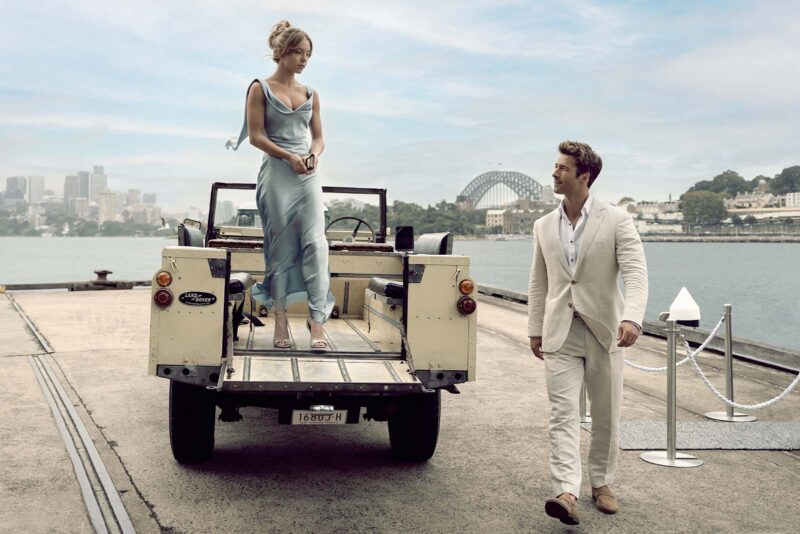
Will always has early screenings where he dissects everything. He gets to a place where he feels good with the cut. It’s about a three or four-week process. Then we screen it for friends and family once a week for at least another month or two. Sometimes we would watch in the cutting room and then we’d watch it in front of a hundred of our nearest and dearest. It was clear early on that too much family time was taking away from the main conflict. Having their families clock the chemistry between Glen and Sydney every moment took away from the conflict, which was that these two people hated each other. There was too much charming stuff.
It took awhile to figure out who we should lose and how to make it work because the story wouldn’t have functioned if it was just the Ben and Bea characters. You need to see that they’re driving the other family members crazy and that the wedding is going to fall apart. And Bea has conflict with her parents and her decisions about her future. There’s an ex-boyfriend and an ex-girlfriend. When you took too much of that out, the audience couldn’t follow the plot. It was a balancing act.

MF: It’s interesting that something as simple as a character observing a scene can add to or subtract from the likability of that character. That’s a big component of something like this. Without conflict, you don’t have a movie, so you have to find a way for the audience to like your characters through conflict. They’re going to have flaws, but they still have to be redeemable.
Regardless of what’s in the script and the dailies, you’re the one that has to manage and massage it so everything works just right. When you’re cutting a film, how do you make the leads likable yet believable as antagonists so they can introduce conflict, but still get a reward and fall in love at the end?
Kim Boritz-Brehm: I think it’s about finding the right moments between the characters. Ben and Bea hate each other for a majority of the movie, so as an editor you’re thinking, “How are we going to create their chemistry or make their love believable at the end?” Setting up their love at the very beginning in their meet cute helped the film. We didn’t initially have that, so I think it was harder for audiences to believe that these two characters could fall in love in just one night. Having them spend time together throughout the day and the little nuances of walking and talking helped.
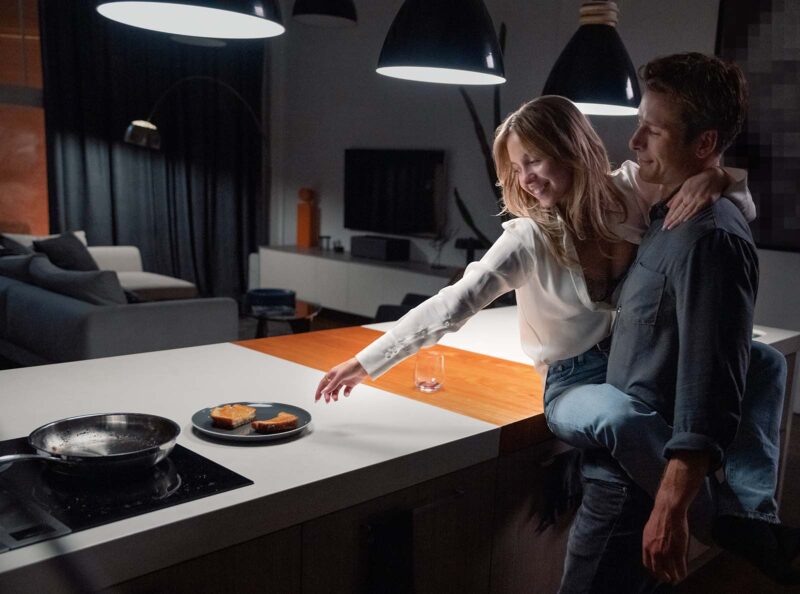
MF: How do you work with the leads in these kinds of movies? Are you thinking about the audience being aligned with Ben or Bea? Are you careful to track how much time we’re spending with one versus the other?
Tia Nolan, ACE: Yes, we found early on, at least at the time, that Sydney Sweeney was the better-known actor. And rom-com audiences have a tendency to follow the female character more. Early on, we had plot stuff that explained her presence, but we didn’t spend a lot of emotional time with her alone. So people gave us notes saying, “We think it’s Bea’s story.” It was never Ben’s story, but at one point it was both of their stories. But everyone was set on following her and as a result, they wanted more. Ultimately, we did three days of ridiculous, very successful additional photography.
But the interesting question is, what do audiences want out of a rom-com? Anything that we did to make it different from a 1990s rom-coms, or different from a streaming rom-com, was not appreciated. Audiences wanted to lean into the classic feel of a romantic comedy and have all of the classic setups to get you there with those two characters. So our biggest hurdle was figuring out Bea’s character trajectory and making both of them likable at the beginning.
Glen has a tendency to just squint and smile and I think people were instantly charmed by that. And because everyone was drawn to thinking the female character was the one they were following, they put a little more weight on what Bea was doing and her decisions.
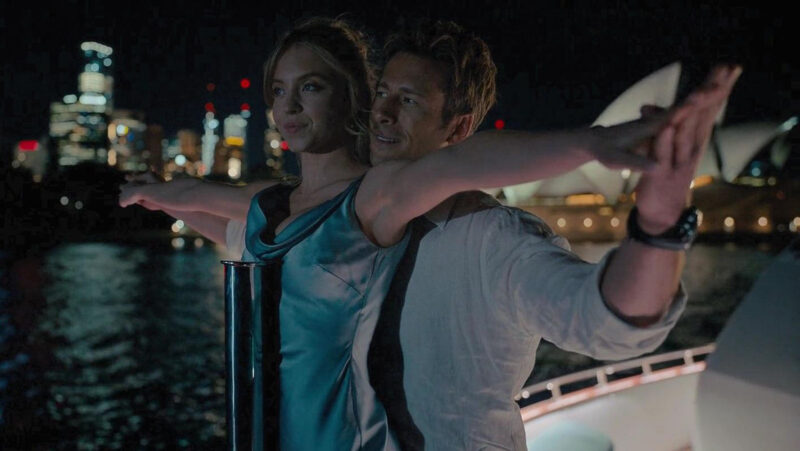
MF: Now is as good a time as any to talk about the box office because it is remarkable. Last I checked, I think Anyone But You currently sits at about $170 million. We have a $25 million rom-com making $170 million worldwide, and it’s made a little more worldwide than domestic, which is expected for action, sci-fi, and horror, but unheard of for a rom-com. Comedy can be so specific to the nuances of a region or a language. Do you even consider worldwide audiences when you’re vetting the comedy?
Tia Nolan, ACE: I can only speak to our conversations in the cutting room. I believe we sort of addressed it as, “This is going to be a U.S., Australia, UK, kind of movie, but maybe not as much of an international draw. It’s not an action movie and Glen and Sydney aren’t the biggest stars in the world. They’re well known in a small pocket of the US. I have a 17-year-old and a 21-year-old and they absolutely know who Sydney Sweeney is. My son only knew Glen Powell because of Top Gun: Maverick. My daughter did not see it.
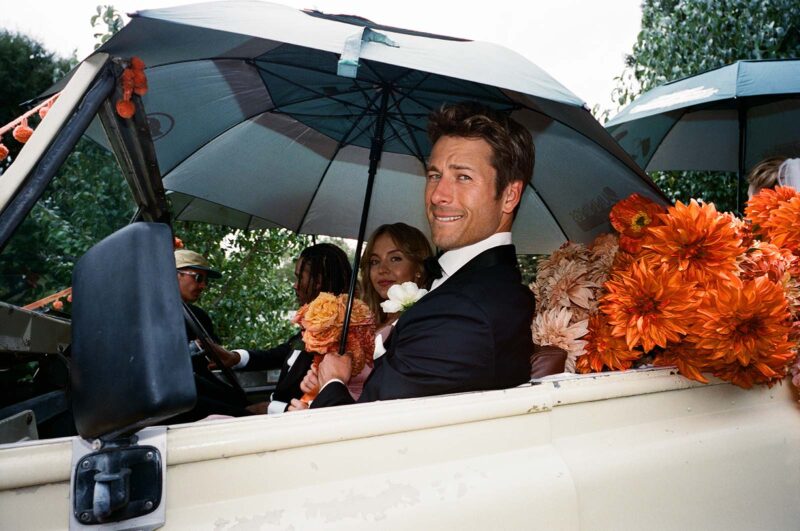
I should call out our cutting room staff here. Nick Coker was our first assistant, Rachel LaFond was our second assistant, and our PA was Luna Santaolalla. They were all in that late twenties, early thirties age group, so they all knew Sydney more than Glen. But with tracking and things, I think the studio found that not a lot of other regions knew these guys. So I don’t think we ever counted on that international box office.
But I think that is a testament to romantic comedy. People just want to feel happy. They want to go out and watch something that makes them feel pure joy. And when you see this movie, you’ll be singing a little song as you leave. I think social media has also helped this film, but if it was just social media, I think it would only affect the English-language regions, and it’s not. So I think it speaks to people wanting to feel good.
People just want to feel happy. They want to go out and watch something that makes them feel pure joy.
MF: Tia has worked with Will for a while now. Kim, this is your first opportunity to work with him. What do you think about Will’s style and how he shoots? Does he give you a lot of coverage, or a lot of alts? Does he encourage improv? What was your take on his shooting style?
Kim Boritz-Brehm: He does all of that. Lots of angles, lots of cameras, lots of things that are beautifully shot. Will just has an eye for the camera. He also has a great relationship with his actors. He can direct them into the read that he wants. Will has a great understanding of the scenes, which helps Tia and me. I love his relationship with the actors. That’s where it starts. A movie is made in writing, but if you can’t get your actors there, you’re not going to have a great movie.

MF: I’m going to quote another editor. I’m not going to use their name because I didn’t ask permission. But this editor said, “If I started with the first take, I would be using early performances, most of which are going to be replaced by better work later. If the best jokes arrive in the last take, it’s much faster to start with those in place.” Do you start looking at later takes first and go from there? Or do you take your time and watch all the dailies linearly from the beginning?
Tia Nolan, ACE: I watch everything because I was brought up in the old-school film days. Every day, I start by watching the dailies as they come in. I don’t say, “I’m going to watch just this scene’s dailies before I cut it.” I watch all of it so I can write my little report. Then I can tell anybody, producers, director, anything that they may need for the next day’s shoot. During that time, I’m also making notes about what I like.
If you can’t get your actors there, you’re not going to have a great movie.
With Will, because he never turns off the camera, I can hear him directing the actors. I can see how he’s changing the scene. We established this workflow on Friends with Benefits where I listened to how he was changing a scene through the footage. He will change dialog on the spot or he’ll throw alts into the scene and I can kind of hear what’s bothering him and why he’s changing it. He’ll say, “This dialog is not feeling right” or “This logic doesn’t work”, that kind of stuff. And that helps. But it also means that you have to sort through all the downtime. That’s not very easy when you have that much footage.
When I’m about to cut a scene, I rewatch the sections that I’m working on again and again, every take. I want to make sure I know which was my favorite take. I’ll double-check line reads and make sure, “Do I have my favorites in here right now?” because sometimes a line read is great in dailies but bad in the scene.
Kim Boritz-Brehm: When I sat down with you at the beginning, you told me how Will talks in between takes. Because of that, I knew what to look for if I got confused. That made everything a lot easier. If Will is having the actor do six or seven line reads in a row, I know he’s probably going to want to use the last or the next to last take. I think it’s all about looking for those things.
Tia Nolan, ACE: To add to that point, though, there are actors who are better in like the first, second, and third take. As the shoot goes on, in later takes or as the coverage gets closer, it feels like the lines start to get a little less genuine. That’s not the norm. I find that actors will usually hold back in the wider shots and save their stronger performances for the close-ups.
In this case, there were moments where some earlier takes were better for performances and emotions. Sometimes there were a lot of stops and starts because the actors were trying to find the comedy and the rhythm of some particular lines. When that happened and the takes went on and on, sometimes it felt like the deeper emotions got lost.

MF: Tia, you said two things that reminded me of other questions. You mentioned wide shots and you talked about a performance waning as it’s being repeated over and over again. In comedy, when you hear a joke for the first time, it lands. But in your role, you’re hearing it a hundred times and after that, it just doesn’t have the same effect. What do you do if you’re starting to lose faith in a comedic beat? Do you have people that you go to tell you if it’s funny or not?
Tia Nolan, ACE: I go to my crew. This particular team gelled together so well. We all had fun together. We always played trivia games over lunch. Our personalities fit so well together. It helped to work with this particular crew.

A good example of this is when Ben and Bea go on the hike. It’s the spider-in-the-pants scene. I knew what takes had brought me to tears when I was watching dailies, so I used those. That’s my go-to first and foremost. But as I was building the scene, it got stale to me. I realized that I had no idea if it was going to be funny or t boring or if I was going too far. So I brought everybody in and I watched them watch the cut. They laughed to the point of tears and that gave me the confidence to go back in and make whatever little adjustments I needed to make.
I wasn’t living in the, “Oh my God, this is terrible” zone anymore. Your brain can do that. It can stop you from moving forward. There are times when I will start to lose confidence in something that I’m cutting. I start to think, “The whole thing is terrible. Do I start over again?” At that point, you need to bring other people in and find out if it’s working or not.
I start to think, “The whole thing is terrible. Do I start over again?”
MF: You mentioned that the performance might change as the coverage is getting closer. I’ve heard that comedy is found in wide shots. Is that an overgeneralization or do you find that you’re usually staying wide for a punchline?
Tia Nolan, ACE: I think that’s about physical comedy. Logically, you miss stuff if you can’t see it, so you want to go wider if the bit involves something physical. I think it depends on what the comedy is based on. I do a lot of dialog comedies and I’ve done physical comedies, like Thunder Force and Superintelligence, which has Melissa McCarthy doing more fun physical stuff.
This film had a lot of biting banter early on. At the beginning, Bea and Ben are in a bar and they’re just going at each other with banter. We tried to go wide for certain shots, but when we did the whole scene would deflate. You just needed to see them sparring side by side. So it depends on what the scene is asking for.

MF: Tonally, this movie is rated R for good reason. There are a lot of F-bombs in this movie, and a little bit of quick nudity. I could see how this movie could be toned down to PG-13. Were there any discussions about that?
Tia Nolan, ACE: Initially, there was a lot more nudity. I don’t know if this has been spoken to in interviews, but we had even more nudity at the top of the movie. This is an interesting movie because of some of the additional photography things that we did.
Thomas Rothman, the head of Sony Pictures, gave us a note early on to cover ourselves with certain things just in case the nudity didn’t work. Thank God he did because it didn’t. There was more crass language that didn’t make the cut. The original approach from a marketing standpoint was to make it an R-rated comedy because you’ve got Sydney Sweeney, whose fanbase is going to be Euphoria. Her fans are people who don’t live in the fairytale twinkly space as much. And I think Will wanted to make an adult movie after living in Peter Rabbit for two films back-to-back.
Anyhow, when we screened for our friends and family and then bigger audiences, people were turned off by anything too sexual. We ended up with a very, I think, elegant sex scene and yes, some F-bombs. That couldn’t be helped. That was already baked in. And I think the R-rating helped us box office-wise because it made it kind of taboo for younger people to see it. A good friend of mine has twelve-year-old daughters and they wanted to go so badly. She ultimately took her daughters to it after she had already seen it.
Kim Boritz-Brehm: There are so many scenes in Anyone But You that use nudity for comedy. If this was a PG-13 movie those scenes wouldn’t have worked as well if at all. Those are the scenes that the audience is laughing at. They’re laughing out loud. They’re enjoying those scenes. And it is funny. It is.
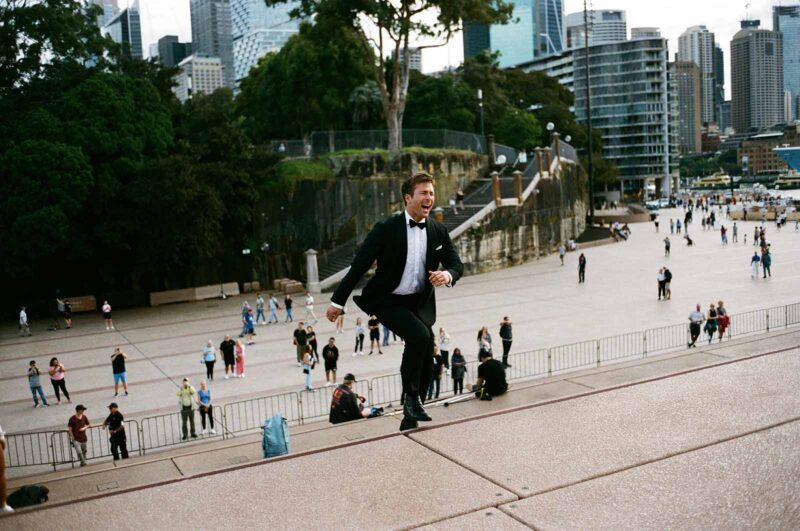
MF: Are there any tricks or techniques you use to manage the media and the story? Do you organize the bins a certain way or color code the timeline? What do you do to try and tame that chaos?
Kim Boritz-Brehm: Tia and I are organized people in general. I try not to have too many dailies in the bins, and I try to organize them either by story or by particular beats. For Anyone But You the problem wasn’t necessarily the amount of footage or the size of the bins. We just had long takes. The average stack would be eleven to fifteen minutes. Tia and I would have our lovely assistants put markers for resets. ScriptSync helps with organization. When we’re sitting with Will he wants to reassess and look at every line read. Instead of having to hunt through each clip, ScriptSync let us color two or three takes that he liked and then narrow it down to just one and swap it out. That saved a lot of time.
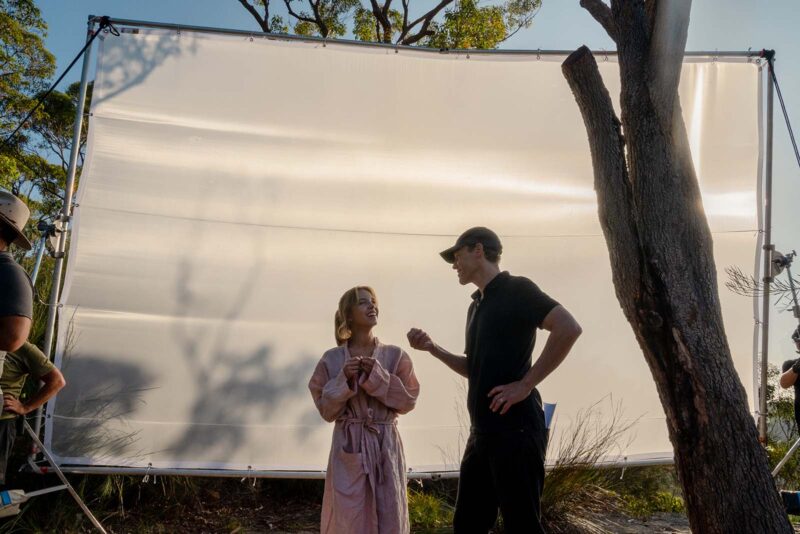
Tia Nolan, ACE: Sometimes you get lost in long takes. It’s hard to find the pieces that you like. Some people pull and make a line read sequence or something like that. I don’t love doing that because if I only focus on those lines, I’m losing what the human faces are doing around that scene. I find some of my best pieces when I’m scrolling through those huge takes looking for the best line read. I’ll see a facial expression that I didn’t clock before. Our team helped keep us sane because there was a lot of footage.
MF: Needle drops are an important component of rom-coms; they certainly seem to be an important part of Anyone But You. One is even written into the story. Before we get into that song, tell me about the needle drop process. Does Will ever give you a playlist? Is that something you work through with a music supervisor? How do you decide on the songs?
Tia Nolan, ACE: Our music supervisor Wende Crowley has been working with Will since his half-hour comedy days, so she is usually brought into the process even long before I am. She helps get licensing for songs that are being written into the movie. Then she sends playlists of the general vibe. “This is what I’m feeling for this scene” or “This is what I’m feeling for the overall tone of the movie.” Will listens to songs, but he doesn’t focus on them unless it’s playback music. He won’t focus on them during production.
Will can’t watch scenes without the perfect song. So we spend a lot of time, and I’m talking days, not editing, but looking for the perfect song. Will has also worked with our music editor Sherry Whitfield since his first movie Fired Up! She also knows the process. But on this, we all pulled together music that we liked we thought would be good.
As you can tell from the movie, it’s nonstop music. Nonstop. Will does not love to score. He wants everything to sound like a song, even if it’s going to be a score. We were very lucky to get Este Haim and her composing partner Christopher Stracey. They found the sound of the movie. They made the score sound like needle drops as well, which was great.
MF: The song “Unwritten” by Natasha Bedingfield is featured prominently in the film. In the credits, the cast sings various bits of the songs. How did you end up putting together an end-credits song compilation?
Kim Boritz-Brehm: It was great having the song laid out. Then it was about going through all the bits and then seeing what worked and which were the funniest. We also had to keep it alive. It could not feel repetitive.
There’s a little part where the brides reveal that they were faking their fight the whole time to push Ben and Bea together. We put that in the middle to break up the song and continue their story. It felt like the brides didn’t get their ending. We set up this whole bit between them of, “Are they not going to get married?” so it’s kind of fun to know that Glen and Sydney were their pawns the entire time. The song took a lot of going back and forth. There was a lot of testing, a lot of swapping, a lot of figuring out what worked. But it was a lot of fun to put together.
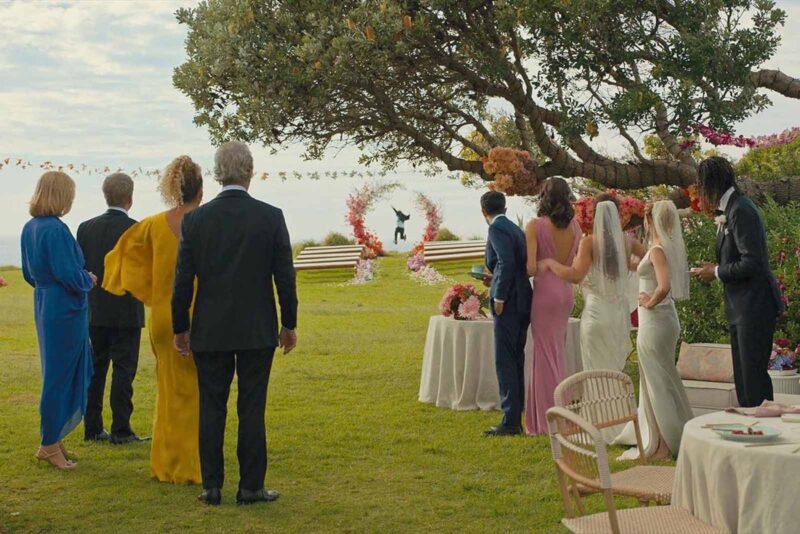
MF: “Unwritten” by Natasha Bedingfield is Ben’s serenity song. He’s not a good flier, so he listens to “Unwritten” to calm down. When things get chaotic in the editing room, what do you both do to find some serenity?
Tia Nolan, ACE: That’s such a good question. I don’t think I’ve mastered it yet.
Kim Boritz-Brehm: We used to go on walks around the Sony lot. That helps.
Tia Nolan, ACE: That helped. Taking a lap and talking out what our approach was going to be helped. We didn’t do it as much once we got to West Hollywood.
I think just checking in with each other was the best thing. Kim keeps me sane, which I’m thankful for every day. Our office had a main kitchen space in the middle of it and our cutting rooms were all bordering it. But we could leave our doors open and because of the lovely acoustics of the space, you could hear everything. So I would maybe be having a tense moment in my cutting room and then I would check with Kim and ask, “Did you hear that? Did I sound like an asshole?”
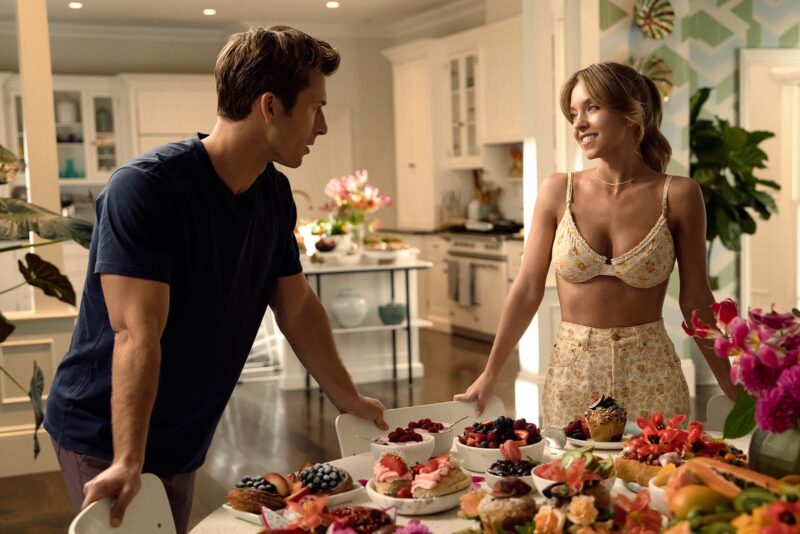
We just kept checking in with each other. If I heard her and Will struggling to find something, I would find a moment to discreetly check in with her and ask, “How’s it going? Let me know if you need me to look at anything.” We would do that for each other. I think that helps. But there were no serenity songs.
MF: If you haven’t mastered serenity in the cutting room yet, don’t worry. That’s what sequels are for.
Tia Nolan, ACE: That’s very, very true.

